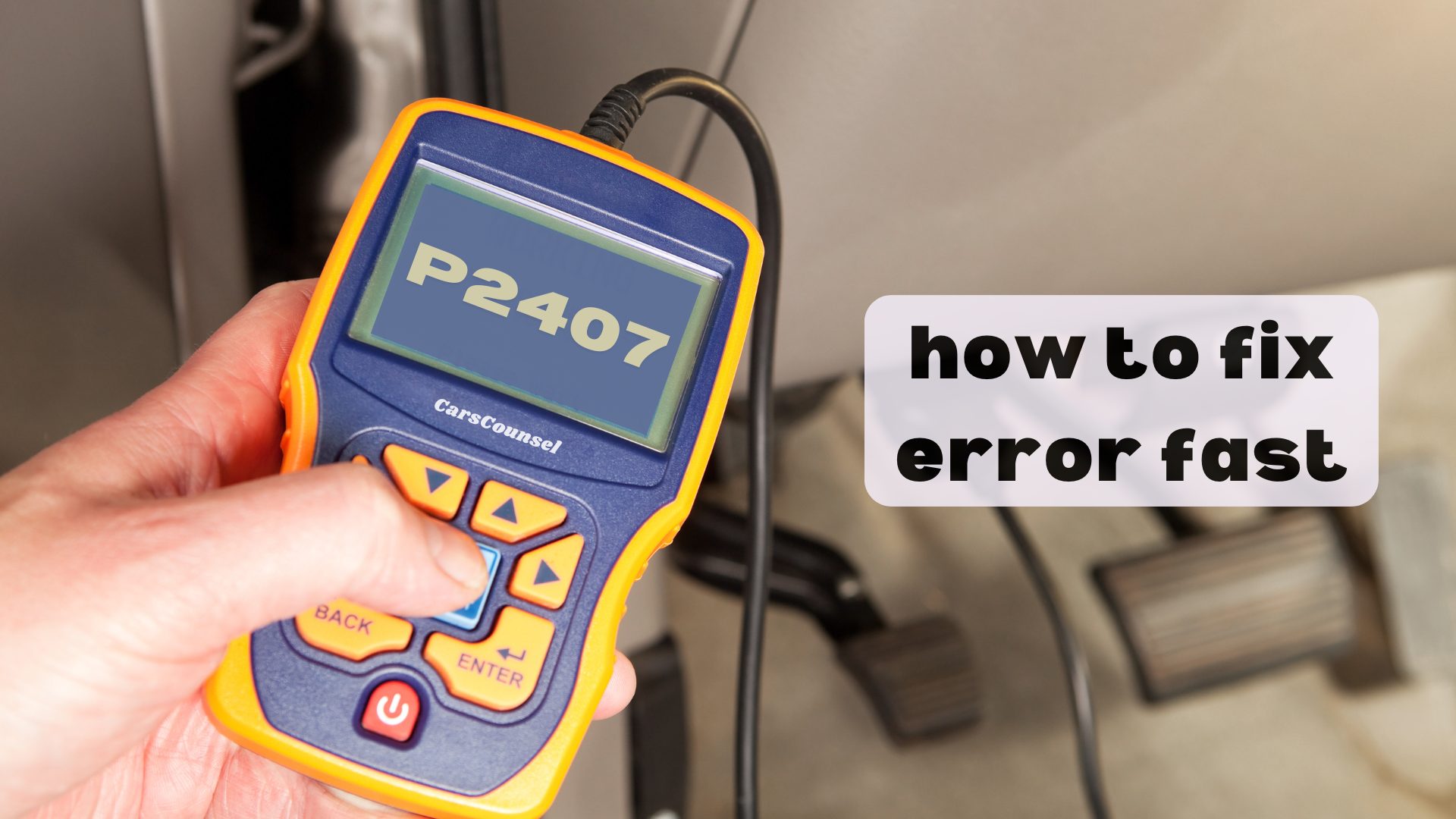Fixing the P2407 code is like solving a puzzle. Start by using a diagnostic scanner to confirm the problem and check for other error codes.
Next, take a look at the leak detection pump, fuel tank vent valve, and fuel filler cap to see if anything is broken or clogged.
Also, check the wiring and electrical connections, as they could be causing the issue.
Once you’ve found and replaced any faulty parts, perform a smoke test and pressure test to make sure everything is working properly.
Need to know the exact steps and tools you’ll need?

Quick Navigation
Key Takeaways
- Inspect and Replace Leak Detection Pump: Use a scanner to confirm the P2407 code, check the pump for any damage, and replace it if it’s faulty.
- Check Fuel Filler Cap: Make sure the fuel cap is tightly sealed and replace it if it’s damaged or cracked.
- Examine Fuel Tank Vent Valve: Check for any clogs or damage, and clean or replace the valve if needed.
- Inspect Wiring and Electrical Connections: Look for any damaged wires or corroded connectors, and fix or replace them.
What Is the P2407 Code?
The P2407 code means there’s a problem with your car’s EVAP system, specifically with the leak detection pump sense circuit.
The EVAP system is important because it keeps fuel vapors from escaping into the air, helping control emissions.
When the leak detection pump sense circuit isn’t working right, the system can’t check for leaks properly, which can lead to fuel vapors getting released. This problem triggers the P2407 code, letting you know there’s a significant issue with your emissions control.
This can affect how your car runs and whether it meets environmental standards.
Symptoms of P2407 Code
When your car shows a P2407 code, you might notice a few signs like the Check Engine Light coming on, the engine running rough while idling, or a drop in how well the engine performs. These are key things to watch for when figuring out the problem.
Here’s what to keep an eye on:
- Check Engine Light: This is usually the first clue.
- Rough Idling: Your engine may feel shaky or uneven when it’s just sitting.
- Performance Issues: You might see a drop in power and how quickly the car accelerates.
- More Fuel Usage: Problems with the EVAP system can make your car use more gas.
Causes of P2407 Code
Causes of P2407 Code
Several things can cause the P2407 code, mainly related to the leak detection pump or parts of the EVAP system. If the leak detection pump is faulty, it can’t properly detect leaks. A clogged or damaged vent valve in the fuel tank can lead to changes in pressure. A loose or damaged fuel filler cap can mess with the fuel tank’s pressure. Problems with the wiring or electrical components in the EVAP system can also make it hard to monitor and function correctly, affecting emissions standards.
| Cause | Impact |
|---|---|
| Faulty Leak Detection Pump | Can’t detect leaks |
| Clogged Fuel Tank Vent Valve | Pressure changes |
| Damaged Fuel Filler Cap | Messes with tank pressure |
| Wiring/Electrical Issues | Problems with monitoring and functioning |
| Loose Fuel Filler Cap | Less effective system |
A detailed check is needed to find the exact problem.
Faulty Leak Detection Pump
A broken leak detection pump can’t find fuel vapor leaks properly, which messes up the EVAP system. If this happens, you need to fix it quickly to avoid bigger problems. Here’s a simple guide to help you out:
- Figure Out the Issue: Use a diagnostic scanner to find the P2407 code. This usually means the leak detection pump is broken.
- Look at the Pump: Check if the pump looks damaged or worn out. If it is, that’s probably what’s wrong.
- Replace the Pump: Take out the broken pump and put in a new one that fits. Make sure all the connections are tight.
- Test Everything: After putting in the new pump, test the system to make sure it’s working and clear any error codes.
Fuel Tank Vent Valve Issues
After fixing the faulty leak detection pump, another common cause for the P2407 code could be issues with the fuel tank vent valve. This part controls the release of fuel vapors, and problems with it can lead to EVAP system errors. Regularly maintaining the vent valve is crucial to prevent clogs and ensure it works correctly. If maintenance doesn’t solve the problem, you might need to replace the vent valve to get the system back in working order.
| Task | Description |
|---|---|
| Inspect | Look for visible damage or clogs |
| Clean | Remove dirt and debris |
| Test | Make sure the valve works properly |
| Replace | Put in a new valve if the old one is faulty |
| Reset | Clear error codes after the repair |
Fuel Filler Cap Problems
One common reason for the P2407 code is a loose or damaged gas cap, which messes with the fuel tank’s pressure and sets off EVAP system errors. Keeping your fuel system in good shape is important to meet emission standards and avoid this problem.
Here’s what you should do:
- Look at the gas cap: Check for any cracks, wear, or if it’s not sealing right.
- Replace if needed: If it’s damaged, get a new cap that matches your car.
- Tighten properly: Make sure the cap clicks firmly when you close it.
- Regular checks: Check the cap now and then during your regular car maintenance to spot any issues early.
Wiring and Electrical Issues
Wiring and electrical problems in the EVAP system can trigger the P2407 code by messing up the communication and function of important parts like the leak detection pump.
To fix this, start by checking the wiring to find any damaged or corroded wires that could be causing issues.
Use a multimeter to test for proper electrical connections and voltage levels at different points in the circuit.
Look at connectors to see if they’re worn out or corroded, as bad connections can cause intermittent problems.
Make sure all wiring is intact and securely connected.
Fix or replace any bad wiring or connectors to get the EVAP system working properly again and clear the P2407 code.
Diagnosing P2407 Code
Diagnosing the P2407 Code
To figure out the P2407 code, start by scanning the vehicle for error codes and visually inspecting the EVAP (Evaporative Emission Control) components and wiring. Use the right diagnostic tools and follow these steps:
- Code Scanner: Plug in a diagnostic scanner to find any other error codes that might be present.
- Smoke Test: Conduct a smoke test to identify any leaks in the EVAP system.
- Pressure Test: Perform a pressure test to verify that the system pressure is correct and to detect any issues.
- Component Testing: Test the leak detection pump and related parts to ensure they are functioning properly and have good electrical connections.
Repairing the P2407 Code
After diagnosing the P2407 code, focus on fixing the identified problems to get the EVAP system working again.
Start by replacing the broken leak detection pump if it’s faulty.
Check for any clogged or damaged fuel tank vent valves and replace them if needed.
Make sure the fuel filler cap is tight and in good shape, as this is often the issue.
Look over the EVAP system’s wiring and connectors for any signs of wear or damage, and fix or replace them as necessary.
Use techniques like smoke tests to make sure there are no more leaks.
To keep things running smoothly, regularly check the EVAP system parts and always ensure the fuel cap is secure.
This proactive approach will help maintain system efficiency.
Car Models Affected
When dealing with the P2407 code, it’s important to know which car models are more likely to have related issues. Knowing which models are more vulnerable can help you stay on top of maintenance and avoid unexpected problems.
Here are some common models affected:
- Audi A6: Often has issues with the EVAP system.
- BMW 325i: Frequently faces wiring problems related to emissions control.
- Ford Escape: Often has problems with the fuel filler cap.
- Toyota Camry: Known for EVAP component failures.
More OBD-II Codes
Frequently Asked Questions
Can a P2407 Code Affect Fuel Efficiency Significantly?
Yes, a P2407 code can seriously affect your fuel efficiency. It messes with the fuel system and emission control, making your vehicle use more fuel and possibly causing it to run rough and lose power.
How Long Does It Take to Fix a P2407 Code Issue?
Fixing a P2407 code usually takes a few hours. This is because mechanics need to run thorough checks and might have to replace some parts.
Is It Safe to Drive With a P2407 Code Active?
Driving with a P2407 code active isn’t safe. It can cause your car to run poorly, use more fuel, and might even damage the engine. Fix the issue quickly to make sure you’re driving safely and meeting emissions standards.
Do I Need Specialized Tools to Diagnose a P2407 Code?
Think of it like solving a mystery. You don’t always need special tools, but having them can make things easier. Basic methods like looking things over and using a scanner can tell you a lot about the P2407 code.
Can Extreme Weather Conditions Trigger a P2407 Code?
Extreme weather can cause a P2407 code by affecting the emissions systems. Changes in temperature and humidity can make seals expand or contract, messing with the leak detection pump and the EVAP system. It’s important to check these systems regularly.
Conclusion
To sum it up, fixing the P2407 code isn’t too hard.
First, use a diagnostic scanner to find the problem.
Then check important parts like the leak detection pump, fuel tank vent valve, and fuel filler cap.
Replace anything that’s broken, make sure all wires are connected, and do smoke and pressure tests to ensure everything is working right.
Finally, clear the error codes to complete the job.
Remember, taking care of your car regularly can prevent future problems.

